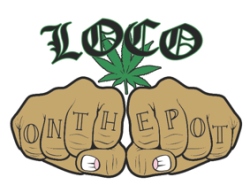 A “dab” is a dose of super-concentrated marijuana — a skosh of weed extract made with solvent, if you will. Smoking solvent-based weed extract isn’t a new idea, however, the notion of doing dabs or “dabbing” is relatively new. And it’s totes all the rage — just check out the dab-centric July 2013 issue of High Times. (See the cover below. She’s smoking a dab out of an apparatus known as an “oil rig.”) In the cover story, “Generation Dab,” Bobby Black says that “smoking ‘flowers’ (as weed is now referred to) is fast becoming passé.”
A “dab” is a dose of super-concentrated marijuana — a skosh of weed extract made with solvent, if you will. Smoking solvent-based weed extract isn’t a new idea, however, the notion of doing dabs or “dabbing” is relatively new. And it’s totes all the rage — just check out the dab-centric July 2013 issue of High Times. (See the cover below. She’s smoking a dab out of an apparatus known as an “oil rig.”) In the cover story, “Generation Dab,” Bobby Black says that “smoking ‘flowers’ (as weed is now referred to) is fast becoming passé.”
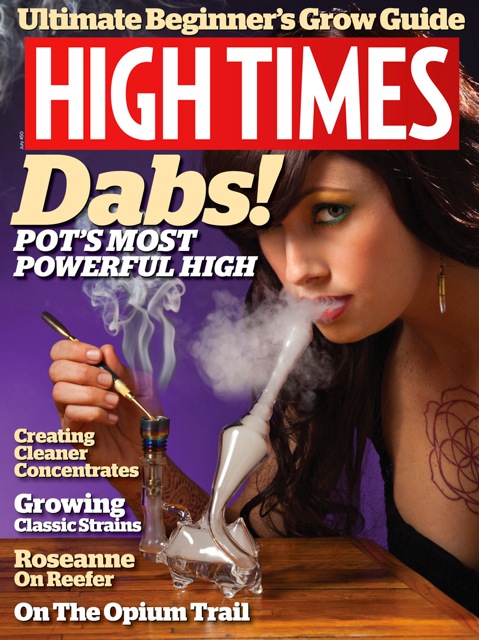
Dabs are made through a chemical extraction process that features the use of butane or other compressed gasses. Depending on the method of extraction, the textures and colors of dabs can vary greatly, from gooey and dark (honey oil), to translucent and breakable (shatter), to crumbly and golden (earwax). (This list is not exhaustive.)
Samantha Miller, president and chief scientist at Pure Analytics, the Santa Rosa-based cannabis potency and safety screening lab, sheds light in an email on just how potent these super-concentrates can be:
“Butane hash oil averages 65% THC by weight and can range as high as 95% by weight in some highly purified examples. This is much higher than the average potency for cannabis flowers, which have an average THC potency of 16.5% for cannabis flowers produced in Northern California. Flowers can have THC levels above 25%, but this is fairly rare and is seen in only a small percentage of the examples of cannabis in Northern California.”
There you have it — just a dab will do ya. Indeed, a dose of butane hash oil — a dab — is a tiny quantity, on the order of 1/10th of a gram.
Since cannabis flowers are so weak and so passé, does that mean that dabs are the future of cannabis? Well, they just might be. After all, according to Lieutenant Wayne Hanson with the Humboldt County Sheriffs Office and team-Humboldt County Drug Task Force, dabs manufacturing is trending in Humboldt. “When we serve a search warrant on a marijuana grow, probably about 50% of the time we find people doing butane extraction to make hash.” He adds, “And there are a couple of explosions every year in the county of Humboldt, people get pretty burnt up, pretty injured.”
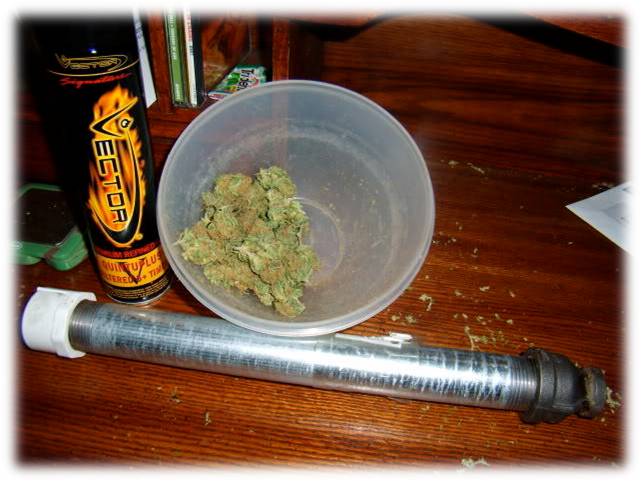
(Above: Some flowers, some butane and a hash oil extraction pipe.)
Oh yeah, that’s right — butane is explosive. Well, that’s a drawback, eh? More on that in a second. Let’s hear a bit more about dabs from Miller first:
“The process of making concentrates using butane or other compressed gases is a chemical extraction process that in most cases will concentrate pesticides and mycotoxins (toxins produced by molds) as well as any other extractable constituent in the cannabis material. Generally speaking, mold or fungus would be killed by the chemical extraction process, however, the toxins they produced before dying will still be present and concentrated as a result of the process. These pesticide residues and mycotoxins are visible in lab analyses.”
Yikes. When asked how common it is to find such nasty stuff in butane hash, Miller says,
“It varies significantly by region. Regions with a more industrial or commercial scale approach to cannabis cultivation have a higher incidence of contamination due to measures taken to prevent crop loss. Where large investments have been made in cultivation, the use of such substances to prevent a loss of investment is more common. The product is viewed as a commodity and the conscientiousness one sees with more boutique farmers is just not present given the focus on profit… One of the most common contaminants in butane hash oil from Northern California is Myclobutanil, a fungicide found in the commercially available product Eagle 20.”
If you don’t know who made your dabs or if you haven’t seen a lab workup, then you don’t know what’s in your dabs — butane extraction does not imply purity. Awesome! Let’s rip a dab of concentrated Eagle 20 and THC… That sounds nice and stoney. Hey, at least molds and fungi aren’t present, right? Yabba dabba do!
Isn’t this a blast? And speaking of blast, who could forget VANSPLOSION? Or this Mack Town fellow — he sustained some serious burn injuries.
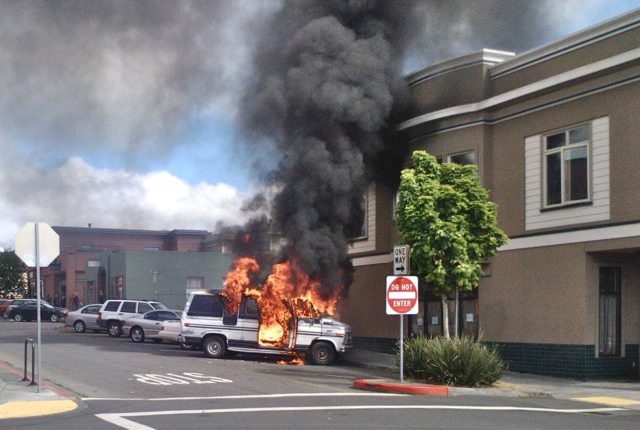
(Above: Butane cans in the van, man — right on. Photo by Ryan Freitas.)
Now, how about some busts? Just a dab: There was the Butane Bonanza at a Humboldt Hill Hash House — three-hundred-fifty-nine cans of butane! The hand grenade guys were allegedly makin’ butane hash too, and so (allegedly) were the Ladies of Briarwood Circle. These boys in Arcata had butane hash manufacturing equipment too, plus a pound of hash, pounds of flowers and a pile of cash. Boom.
Lt. Hanson says that they primarily find evidence of hash labs at indoor scenes and not so much at outdoor scenes. That’s interesting because the High Times dabs article says, “Blasting should never be done indoors…” Do you think those butane bustees were adhering to that cardinal rule?
For those caught with butane hash making materials, it’s bad news bears — Lt. Hanson says “it’s the same charge as if you have a methamphetamine lab,” and it doesn’t matter if you have a 215 card. “If somebody has a butane hash lab in their house and they’re in compliance with medical 215 for their grow, we’re arresting them for a felony butane hash lab, seizing all of their marijuana plants and we’re taking them to jail.” He adds, “with that extraction method, they’re endangering their neighbors, anybody in the house, themselves.”
All of this dabs stuff is such a bummer man, it’s so negative. But people love dabs, and those cannabis concentrates are a huge deal at the medical weed conventions — what a pickle.
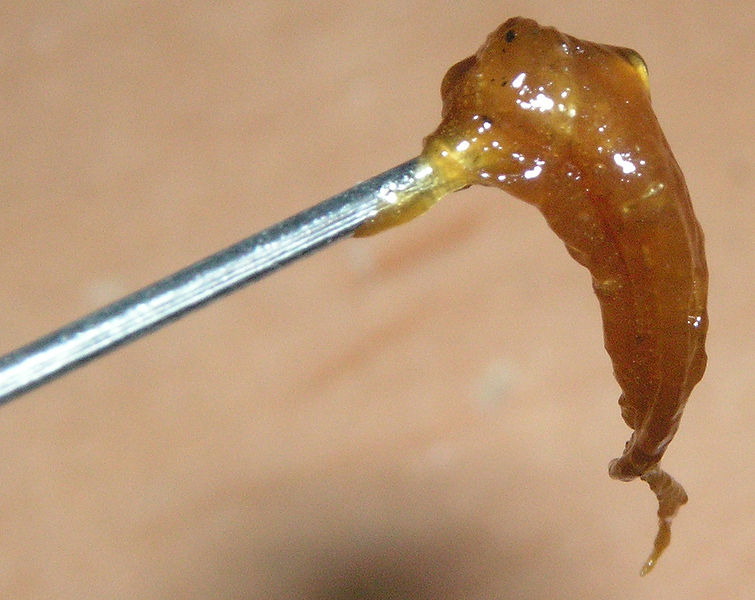
(Above: A dab of butane extract on the end of a paper clip.)
Far NorCal’s very own medical marijuana convention, The 2013 Emerald Cup is scheduled for mid-December. According to Tim Blake, the event’s creator and producer, they had 40 entries last year that were dabs and super-concentrates, but the quality of some of those entries was questionable.
(Master-dab-blasters, you may want to sit down for this paragraph.) This year, the Emerald Cup will not have cannabis super-concentrates in the competition. The team wants to step back until they can get a clearer understanding of the butane hash manufacturing process, and whether butane hash is as pure as people claim or if it’s even healthy to smoke. The EC will have a panel discussion/debate, however, featuring pro-dabbers and anti-dabbers hashin’ it out.
Blake acknowledges that dabs are super popular, and he hopes their choice to keep dabs out of the competition does not have a negative impact on the event. “It’s not just the kids,” Blake says, “it’s everybody — this phenomenon is taking over the whole country.” But Blake doesn’t judge. “The oils, I’m not saying that they’re bad… I don’t want to put people down for doing it.” He just wants everyone to be safe and healthy. “We need to clean it up, we need to teach people how to do it right, so that people are being delivered something really pure.”
Blake says “we’re an outdoor organic cannabis competition — outdoor flowers, and we’re asking everybody to be pure organic.” He says, when you’re looking at something that’s made with solvent, like butane hash oil, “How can you really call that organic?”
There is food industry precedent — hexane is used to extract oils from seeds and veggies. That process is controversial, and it seems like Mr. Blake is right on.
[Ed. note — This story has been updated to include the innocence of those arrested until proven guilty in a court of law. People have been arrested with butane, or with other hash-making equipment — that does not mean, necessarily, that they have been making dabs themselves. The Lost Coast Outpost sincerely regrets the error. —HS]
CLICK TO MANAGE